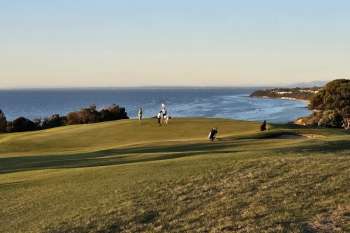Doak opens up on Sebonack, St Andrews, Bifurcation and his best holes
GOLF.com had an interesting live chat with architect Tom Doak today, with topics ranging from his work in Florida, Oregon, Colorado, New York and New Zealand to his views on maintenance budgets, bifurcation and the changes at St Andrews.
Doak’s most telling observations included this on Sebonack,
“I don't love the course as much as I love some of the other projects I've done. I felt like I spent more time than I wanted to on politics, and not enough on being creative. And that's just not as fun for me as collaborating with my own team.”
And this comment on why he would advise against any further changes on The Old Course
“I've spent years of consulting work trying to put back courses to the way they were designed. It's really hard to do. It's much easier to refrain from messing them up in the first place.”
The highlights from Doak’s live chat are published below.
Q - If the owner of a golf course decides to bring in a different architect to do a renovation or restoration to a course you designed, is that considered a slap in your face?
Tom Doak - It's pretty rare for a recently-built course to go under a major renovation, although, lately, some architects are going back to their older courses and making changes because there's not many new courses to build. If one of my clients brought in a different architect to make changes, it would be because I'd let the relationship fall apart, and they didn't have faith in me anymore. But I don't think that's the same as a slap in the face.
Q - If you were head of a governing body and could make recommendations about maintenance practices to make game better how would you recommend bunkers be treated. And would you recommend a rollback on golf ball or equipment?
TD - I'm certainly not much of a politician, so I'm not going to head up the USGA anytime soon. I think way too much is spent on maintenance at most American golf courses nowadays, but it's up to golfers to tell the operators of those courses that they don't want to pay for guys to blow the leaves off the cart paths every morning! As for equipment, I thought David Fay wrote a great article about bifurcation this month in GOLF DIGEST, that it would be easy to change the ball for the professionals under the existing Rules.
Q - What is your favorite hole at the Bandon Dunes Resort and why?
TD - There are a lot of great holes in Bandon. My favorite is probably still the sixth hole at Pacific Dunes. It's just a short par-4 but it seems to mess with the better players even more than it messes with the average visitor, because they have to worry about the deep bunker near the green on the tee shot AND the approach. They could just play it safely, but they can't seem to resist putting themselves at risk by attacking the hole.
Q - What is your favorite hole on Old MacDonald and why?
TD - I guess my favorite hole at Old Mac is the par-4 7th, because we might never have built it if I hadn't walked around with Mike Keiser the day we were starting construction and got onto the topic by accident. Bringing the ocean into view there added an emotional moment to the course that it would have been lacking otherwise. When I took my son out there for the first time, we walked up to the green and the view just made him sit down and soak it in for a few minutes. It takes something special to get that reaction from a 19-year old!
Q - We are taking our 66 year old father to St Andrews in July and will be staying in St Andrews. Other than the old course, what other 2 courses would you recommend we take him to?
TD - Kingsbarns, for sure. And maybe the Eden course at St. Andrews, which is a bit shorter and will be more manageable for your dad. That's the course I played the most when I caddied there in 1982 -- there are a couple of great par-3 holes on the Eden. Most of all, though, if you can be there on Sunday, it's a wonderful experience to walk around The Old Course when it's closed, and then to have a little putting match on the Himalayas putting course by the second tee of the Old Course. Even your mom would enjoy that!
Q - Better short par 4 - 7th at Ballyneal, 4th at Barnbougle Dunes, 6th at Pac Dunes or 14th at Cape Kidnappers?
TD - Hey, those are some of the holes I'm proudest of. Hard to choose. I guess I might pick the 4th at Barnbougle but mostly because I have less chance to get back there and see it.
Q - What's the worst hole you ever built? What went wrong? Did you get a chance to fix it?
TD - My worst hole was almost certainly the 18th hole at High Pointe in Michigan, my first course. We had committed to building the hole down through a wetland area, but when the environmental agency came out to mark in the field where we could go, the areas we had to leave untouched were bigger than I'd anticipated, and that made the hole way too severe for the average player -- playing safe off the tee meant the carry over water for the second shot was too far for them. I probably would have had to change the routing for #17, too, to really fix it. Sadly, the course is closed now, but I don't think the 18th hole was the reason for it.
Q - If you could restore one great classic course that has lost its way, what would it be?
TD - Timber Point, the old Colt & Alison course on the south shore of Long Island. It was a great course back in the day, but the county took over after the club failed in the Depression, and they turned it into 27 holes in order to get more rounds and more revenue. If they would just restore the original 18, it would still be one of the best courses in New York State.
Q - Would you ever consider a collaborative design with Coore and Hanse? Could 3 prominent architects work together like that?
TD - I'm sure we could work together, because we're all pretty much on the same page, philosophically. In fact, many years ago, when Gil still worked for me, I approached Bill and Ben about us all working together. But, as Bill rightly said back then, we don't need that many brains doing one design.
Gil and I actually talked about making a joint proposal for the Olympic project, but we hadn't submitted our original proposals together, so we couldn't change our proposal mid-stream. He doesn't really need me looking over his shoulder, anyway. He'll do a fine job on his own.
Q - How short of a short par 3 can you build and still make it challenging and fun?
TD - The shortest one I've ever seen that I'd say meets the criteria is the 7th at Pebble Beach -- 110 yards. The shortest great one we've built is the "Little Devil" at Barnbougle Dunes, which is about 120. I do think it would be possible to build a great hole that was maybe 90-95 yards, but I've only ever seen a couple of holes at that length, and they didn't quite do it for me.
Q - Any tips for playing Cape Kidnappers? Is there anything that you're especially proud of on that course that I should keep an eye out for?
TD - It's a spectacular setting, but the design of the course is really quite subtle. There are a lot of holes where there's not too much internal contour in the greens, but they are gently sloping away from the line of approach, so they are tough to play to and you're often misreading the speed of putts. The late, great Australian golf writer Tom Ramsey called me after he played it to congratulate me on the greens, and I told him he was the first one who'd ever noticed them!
Q - If you were forced to play one course by Rees Jones, which one would it be?
TD - That seems like it's worded a bit more hostile than it should be. My favorite course of Rees' is Nantucket Golf Club. But the one I want to get back to is Atlantic, where they've done a bunch of work since I last saw it. The superintendent of the course is an old friend of mine and I'm curious to see what they've done with the place.
Q - Which holes at Sebonack do you consider your favorite?
TD - The eleventh is probably my favorite hole there ... it's one of the first holes I found on the topo map, and it turned out to look almost exactly like I pictured it on the plan. But my next favorite hole might be the short par-4 5th, which is one of the holes that Jack Nicklaus had much more to do with than I did.
Q - You collaborated with Nicklaus at Sebonack. Have you other joint ventures planned? Do you think working with another architect involves too much compromise?
TD - The thing about Sebonack was, both Jack and I understood at the beginning of the project that we wouldn't build everything just exactly the way we thought it should be -- that there was going to be a dialogue about everything there. We both approved every hole, but that didn't mean that we loved every hole the same way we do on projects where we make all the decisions by ourselves. It was an experiment, and the success of the experiment was for others to judge, not for us.
I think the experiment was a success, and I think that we both learned something from working with the other; I know I did. But, I don't love the course as much as I love some of the other projects I've done. I felt like I spent more time than I wanted to on politics, and not enough on being creative. And that's just not as fun for me as collaborating with my own team.
Q - Is Merion a Doak 10 anymore based on the changes that have been made for the Open?
TD - I haven't seen the most recent changes, but, it bothers me that the club and the USGA thought they HAD to make a lot of changes to the course so that it could host a big tournament. It would have been more interesting to watch them play the course the way it was, even if the winning score was a bit lower.
Q - What's are the strengths and weaknesses of your game and does that play a role in how you build your golf courses?
TD - I can hit it just about anywhere, but I'm pretty inventive with recovery shots, especially around the greens. And that's pretty much exactly what my courses are like. Some good players think I don't punish golfers enough for being wild off the tee, but I'm trying to build courses where everybody can have fun, and it's no fun playing your second shot sideways.
Q - You're pretty outspoken. Any comments or statements you regret or would like to take back?
TD - For sure. I think everyone says things they'd like to take back; it's just harder for me to take them back because I've said them in print. I guess the main thing I'd say is if someone has taken something personally, I've really never meant to criticize somebody personally -- I've always tried to make my comments about the work that was done and the philosophy of golf behind it.
Q - Did you apply for the Chambers Bay job? If so, how did that site compare to Streamsong?
TD - We weren't even selected as one of the top 5 architects to compete for that job. I thought that right after building Pacific Dunes, we might have been considered; but on those public-RFP jobs there is just way more politics going on behind the scenes than I know how to deal with. I'm impressed with the course.
Q - Tom, you were on the forefront in the charge against the changes made to the Old Course. Have you had a chance to see the work that Hawktree did or get a tour from Peter Dawson? Would you try to convince them against making the second round of changes, or has that ship sailed?
TD - I have not had a chance to see the work -- and I understand that it's not up to me to approve of it or not. I really doubt that either Dr. Hawtree or Mr. Dawson care what I think; if they cared what others thought, they would have put their ideas out for public comment, instead of keeping the plans secret until three days before the work commenced.
And, yes, I'd try to convince them against making further changes to The Old Course. I believe there's a wisdom within The Old Course that goes beyond what anyone today understands about golf course architecture. If we reduce it to talking about whether this change or that was carried out okay, that is really not the point. It really worries me that the people in power in golf think so little of suggesting changes to even the most sacred of courses. I've spent years of consulting work trying to put back courses to the way they were designed. It's really hard to do. It's much easier to refrain from messing them up in the first place.
Back to News
More News
Report reveals golf's $3.3 billion contribution to Australia
AGIC report reveals total annual benefits to the Australian community, economy and environment from golf.
Cape Wickham Links – The Inside Design Story
Co-designer Darius Oliver reveals the truth behind the design of Australia’s premier modern golf course
Have your say on the future of Moore Park Golf
Golfers unite – another one of our cherished public access golf courses is under threat
Cameron John wins The National Tournament by two strokes
Victorian claims breakthrough professional victory at The National Tournament presented by BMW



